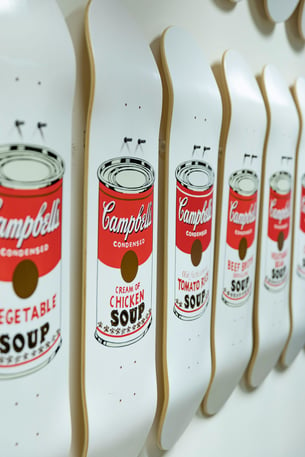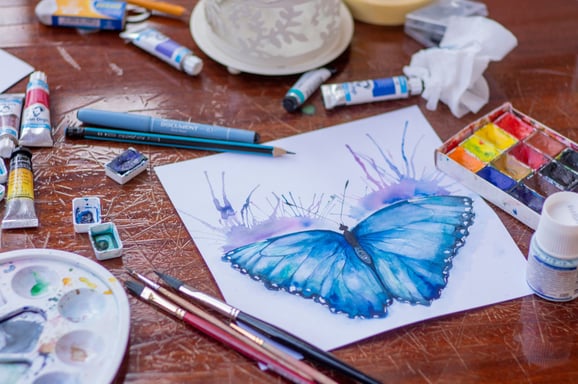Do you create for the market, or do you create what you want to create? Is it possible to do both? What kind of art sells best? Questions like these can cause you to become paralyzed in indecision. If you want to create art that sells, start by identifying your perfect buyer. What do they wear? Where do they live? What does their house look like and where is it located? What is their job? What colors do they like? What imagery are they drawn to? From that point, you can begin considering the types of art that would most appeal to them. Keep reading to learn about the current art trends for today's artists and collectors.
1 - Abstract
Non-objective abstract art does not use recognizable imagery and does not depict any specific subject. It is made up of shape, form, line, value, texture, scale, and color. As an abstract artist, you create something beautiful, compelling, poetic, and engaging with only those elements of art. The number one quality of having a good abstract piece is to have at least five fields of depth in the foreground, middle ground, or background.
Abstracts have a color story. Color and home décor follow fashion. What you see mirrored on the runway will soon follow in the home. Create using color that is rich, and not too bright. Avoid making your paintings muddy. This will help your color to feel alive. Color should be tasteful. 
Choose colors that your buyer wants to live with. Avoid out-of-the-tube primary pallets and use neutrals to balance the bold colors. When in doubt, use a color wheel to create your color story. If lines are part of your composition, have a variety of lines. Intentionally create exciting lines. When adding texture, create variety in your textures, including abstractions, thick, thin, and midrange.
Avoid painting everything the same scale size. Artists tend to paint everything to the size of their hand. Study great composition and have a clear focal point. Objects should come off the edges of a piece, avoid triangles in corners, and have tangent edges. Abstract art allows you to set a mood for a space. Visualize the space you are creating for as you plan your work. For example, a minimal abstract piece with resting space can allow a room to hug a potential buyer with a sense of peace. If you want to get your art into galleries, create pieces that will complement a particular gallery’s architecture and environment before approaching a curator.
2 - Realism
Realism is painting a subject or subjects that can be clearly identified. They can include landscapes, nature, wildlife, figures, and still life. Creating identifiable subjects of local landmarks and events can help you sell your art locally and can be popular with the tourist market in your region.
For a broader reach, choose themes and locations that are open-ended and not too specific. Don’t force your message on potential buyers, and avoid creating a riddle that will be confusing. A buyer does not want to feel stupid. Realism can tell a story, but shouldn’t make the buyer feel like they are not smart enough to understand it.
Do what you can to keep people engaged in your art. That might mean your still-life pieces should have a unique twist to them. Gone are the days of the typical still-life. Buyers are not interested in a bowl full of fruit because it’s one of the most over-painted subjects in history. Create beautiful pieces that will bring calm to a home.
3 - Figurative
 Figurative work captures humans, animals, and objects from real life. They are rendered recognizable. In the past, figurative work has told our history as human beings. Today, buyers want paintings with an aesthetic that they want to be part of. Create a visual that appeals to people’s fantasies and are uplifting. If you want to create art that sells, create your figures in an appealing way, regardless of the body type. It would be a hard sell if all of your figures look strained, out of proportion, traumatized, or are in environments where they appear not to like themselves. Paint the other side of human pain. Do you want collectors to come back? Show hope, perseverance, and triumph.
Figurative work captures humans, animals, and objects from real life. They are rendered recognizable. In the past, figurative work has told our history as human beings. Today, buyers want paintings with an aesthetic that they want to be part of. Create a visual that appeals to people’s fantasies and are uplifting. If you want to create art that sells, create your figures in an appealing way, regardless of the body type. It would be a hard sell if all of your figures look strained, out of proportion, traumatized, or are in environments where they appear not to like themselves. Paint the other side of human pain. Do you want collectors to come back? Show hope, perseverance, and triumph.
4 - Portraiture
Portraiture art is capturing a face as a focal point. It can be made using various mediums, from stone to paint to charcoal. Unless you are doing a commission of a particular person, try to create using models that possess universal beauty. Your buyer may not want a picture of a specific person, but a person who reminds them of someone. Or they may want a recognizable figure. That is why there is a large market for fan art. The pet market is one of the only markets that is recession-proof, so many artists offer pet portraits.
What story are you trying to tell in the portrait? This can be told through clothing, position, other objects, and the environment. What is the overall feeling that is coming from your portrait? A face that shows hope will always sell over a face that shows struggle. A person might connect with a negative emotion for a moment, but will not likely want to live daily with it in their home. Paintings where a subject is looking directly at the viewer are less sellable because they can feel confrontational. Use color that makes the skin come alive rather than dead, sickly tones.
5 - Pop Art
Pop art emerged in the late 1950s and still sells today. It mainly depicts recognizable commercial elements such as products and celebrities. Elements that are typical in pop art are bright colors, strong typography, repetition, humorous themes, and social commentary. You can still find pop art styles in many of today’s graphic works, mixed media paintings, graffiti/murals, and fan art. Work by Andy Warhol still sells well in today’s market. Nostalgia art can pull a buyer off the street in a gallery window.
Photo by Jean-Philippe Delberghe on Unsplash
6 - Urban
Urban art tends to be scenes of city environments or of those living in city environments. It is often made in the form of graffiti, murals, and installations. The subjects can be social, political, or cultural commentary and represent the heartbeat of the culture living around it. It draws its inspiration from pop art, expressionism, and surrealism. Urban art requires artists to think outside of a traditional canvas, putting their art on walls and other architectural features. Some communities have art initiatives that give grants to public art. Creating urban art in prominent areas can help establish an emerging artist as a known local artist. Most famous is the artist Banksy, who has used gorilla art installations to rise in notoriety. More and more businesses are looking for artists who can create murals to meet the needs of Instagram-worthy environments.

7 - Niche Art
Niche art arises from a common passion between the artist and the buyer. This type of art not only has the potential to be highly profitable, but it also benefits from the artist's genuine interest in the subject matter. Instead of aiming for a wide audience, niche art targets a specific fan base—this could include cat lovers, fandoms, or gardening enthusiasts, etc. When unsure of what to paint, choose a subject you love. Your passion and insider knowledge of the hobby will shine through in your artwork.
Photo by Dylan Mullins on Unsplash
8 - Your Art
You might not know how to sell your art yet, but your art could be the art that sells best. Regardless of the style or subject you choose to paint, paint what you are being drawn to. This is not necessarily the art you want to live with but the art you are most passionate about creating. 
You may want to live with a minimal style in your home but love to create bold-colored urban pop art for your buyers. There are two types of artists, artists who paint what they think the market wants and artists who paint what feeds their soul. You can do both. If your ideal buyer loves bears, you can create a series of bears in your specific style. Maybe you love coffee and your ideal buyer loves minimal paintings so you create a series of coffee cup circle ring stains using coffee-based paint. Let your passion and ideal client drive you.
Photo by Elena Mozhvilo on Unsplash
Start Now
Creating art that sells starts with you knowing your superpower. Your art style and the subjects can come after. An art career is simple. It just comes down to hard work and perseverance. You must persist, and to do that, you have to be deeply in touch with your purpose. Every time resistance tries to come and beat you down, you must know what your purpose is in order to be willing to face the risks, the unknown, and the adventure that goes along with being an artist.
Your purpose is the motor that will propel you on the days when you have doubts and you second-guess yourself, when your faith has gotten small. Know what your purpose is so that your belief will rekindle your drive, your perseverance, and your motivation.
When the accolades stop, you need to be able to face resistance. It is really important that you know who you are, and your purpose is not just being an artist. Art is your vehicle, and an art career is your vehicle to your purpose. How do you find your purpose? It is the opposite of your pain, your wounding, and your trauma. You are the only one who has gone through what you have gone through, and you understand the hope on the other side of your story. If this resonates with you, take the Milan Art Institute’s Mastery Program. Besides being a program that will grow your skills and help you narrow down your voice and process, you will be encouraged and guided to identify your superpower.
